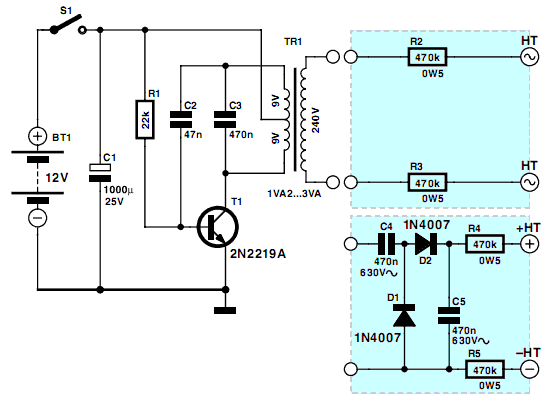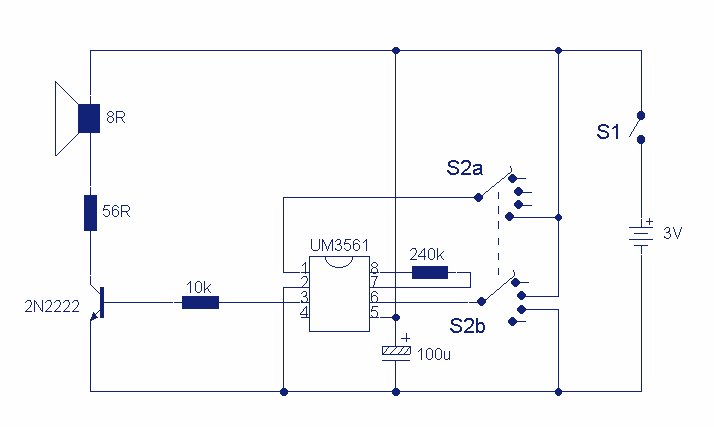
Mini High-Voltage Generator

This project is designed to enhance security for personal belongings left unattended on a beach towel, in an office, or workshop setting. It utilizes a compact circuit powered by standard primary cells or rechargeable batteries to generate a low-energy, high voltage in the range of 200 to 400 V, which is harmless to humans but can deliver a significant shock to anyone who touches it. This project serves as an educational tool for hobbyists, particularly those interested in radio technology and valve circuits. The circuit consists of a single active component, a standard transistor, functioning as a low-frequency oscillator. This oscillator converts the DC voltage from the battery into an AC voltage that is amplified by a transformer. The design employs a center-tapped transformer to create a Hartley oscillator, a well-known L-C oscillator named after Ralph V. L Hartley. For the oscillator to produce a proper sine wave output, the intermediate tap's position must be carefully selected for the desired voltage reduction ratio. Although the transformer used may not allow for optimal inductive tapping, its central position ensures reliable oscillator startup. The circuit's output voltage is safely managed through two current-limiting resistors, which must not be omitted or altered. The circuit can produce approximately 200 V peak-to-peak, with an optional voltage doubler that increases the output to around 300 V. The circuit operates with a current draw of only a few tens of mA. For prolonged use, AAA size Ni-MH batteries in groups of ten are recommended to avoid frequent battery replacements. Measuring the output voltage with a multimeter may yield lower readings due to the non-sinewave nature of the output, but an oscilloscope can provide accurate readings. To implement this project for securing personal items, two small metallic areas should be attached to the handle of a bag, ensuring that unwanted hands will touch both terminals simultaneously.
The circuit operates by employing a simple yet effective design that converts low-voltage DC power into a high-voltage AC signal. The core of the circuit is a transistor configured as a low-frequency oscillator, which is crucial for generating the necessary alternating current. The Hartley oscillator configuration is particularly advantageous in this scenario due to its ability to produce high voltages with minimal components. The use of a center-tapped transformer allows for feedback to sustain oscillation, ensuring the circuit remains operational without requiring complex adjustments.
The output stage of the circuit is critical for safety and functionality. The inclusion of current-limiting resistors (R2 and R3) is essential to prevent excessive current flow, which could lead to dangerous situations. These resistors are designed to limit the output voltage to a safe yet effective level, ensuring that the device can act as a deterrent without posing a significant risk to users. The optional voltage doubler circuit, involving additional resistors (R4 and R5), further enhances the output voltage for increased deterrence.
The circuit's power consumption is notably low, making it suitable for extended periods of use. The recommendation to use rechargeable batteries helps to minimize operational costs and environmental impact. It is also important to note that the output waveform's characteristics may lead to discrepancies when measured with standard multimeters, which are typically calibrated for sine wave signals. Therefore, using an oscilloscope is advised for accurate voltage measurements.
In application, the project can be effectively integrated into personal items such as bags or cases. By strategically placing the metallic terminals, the circuit can create a barrier against unauthorized handling. Care must be taken by the user to ensure they do not inadvertently activate the circuit while using their belongings.
Overall, this project not only serves a practical purpose but also offers valuable insights into electronic circuit design and operation, particularly for those interested in historical technologies and their modern applications.Here`s a project that could be useful this summer on the beach, to stop anyone touching your things left on your beach towel while you`ve gone swimming; you might equally well use it at the office or workshop when you go back to work. In a very small space, and powered by simple primary cells or rechargeable batteries, the proposed circuit generat
es a low-energy, high voltage of the order of around 200 to 400 V, harmless to humans, of course, but still able to give a quite nasty poke` to anyone who touches it. Quite apart from this practical aspect, this project will also prove instructional for younger hobbyists, enabling them to discover a circuit that all the oldies` who`ve worked in radio, and having enjoyed valve technology in particular, are bound to be familiar with.
As the circuit diagram shows, the project is extremely simple, as it contains only a single active element, and then it`s only a fairly ordinary transistor. As shown here, it operates as a low-frequency oscillator, making it possible to convert the battery`s DC voltage into an AC voltage that can be stepped up via the transformer.
Using a centre-tapped transformer as here makes it possible to build a Hartley` oscillator around transistor T1, which as we have indicated above was used a great deal in radio in that distant era when valves reigned supreme and these was no sign of silicon taking over and turning most electronics into solid state`. The Hartley` is one of a number of L-C oscillator designs that made it to eternal fame and was named after its invertor, Ralph V.
L Hartley (1888-1970). For such an oscillator to work and produce a proper sinewave output, the position of the intermediate tap on the winding used had to be carefully chosen to ensure the proper step-down (voltage reduction) ratio. Here the step-down is obtained inductively. Here, optimum inductive tapping is not possible since we are using a standard, off-the-shelf transformer.
However we`re in luck ” as its position in the centre of the winding creates too much feedback, it ensures that the oscillator will always start reliably. However, the excess feedback means that it doesn`t generate sinewaves; indeed, far from it. But that`s not important for this sort of application, and the transformer copes very well with it. The output voltage may be used directly, via the two current-limiting resistors R2 an R3, which must not under any circum-stances be omitted or modified, as they are what make the circuit safe.
You will then get around 200 V peak-to-peak, which is already quite unpleasant to touch. But you can also use a voltage doubler, shown at the bottom right of the figure, which will then produce around 300 V, even more unpleasant to touch. Here too of course, the resistors, now know as R4 and R5, must always be present. The circuit only consumes around a few tens of mA, regardless of whether it is warding off` someone or not!
If you have to use it for long periods, we would however recommend powering it from AAA size Ni-MH batteries in groups of ten in a suitable holder, in order not to ruin you buying dry batteries. If you build the version without the voltage doubler and measure the output voltage with your multimeter, you`ll see a lower value than stated.
This is due to the fact that the waveform is a long way from being a sinewave, and multimeters have trouble interpreting its RMS (root-mean-square) value. However, if you have access to an oscilloscope capable of handling a few hundred volts on its input, you`ll be able to see the true values as stated.
If you`re still not convinced, all you need do is touch the output terminals. To use this project to protect the handle of your beach bag or your attachecase, for example, all you need do is fix to this two small metallic areas, quite close together, each connected to one output terminal of the circuit. Arrange them in such a way that unwanted hands are bound to touch both of them together; the result is guaranteed!
Just take care to avoid getting caught in your own trap when you take your bag to turn the circuit off! 🔗 External reference
The circuit operates by employing a simple yet effective design that converts low-voltage DC power into a high-voltage AC signal. The core of the circuit is a transistor configured as a low-frequency oscillator, which is crucial for generating the necessary alternating current. The Hartley oscillator configuration is particularly advantageous in this scenario due to its ability to produce high voltages with minimal components. The use of a center-tapped transformer allows for feedback to sustain oscillation, ensuring the circuit remains operational without requiring complex adjustments.
The output stage of the circuit is critical for safety and functionality. The inclusion of current-limiting resistors (R2 and R3) is essential to prevent excessive current flow, which could lead to dangerous situations. These resistors are designed to limit the output voltage to a safe yet effective level, ensuring that the device can act as a deterrent without posing a significant risk to users. The optional voltage doubler circuit, involving additional resistors (R4 and R5), further enhances the output voltage for increased deterrence.
The circuit's power consumption is notably low, making it suitable for extended periods of use. The recommendation to use rechargeable batteries helps to minimize operational costs and environmental impact. It is also important to note that the output waveform's characteristics may lead to discrepancies when measured with standard multimeters, which are typically calibrated for sine wave signals. Therefore, using an oscilloscope is advised for accurate voltage measurements.
In application, the project can be effectively integrated into personal items such as bags or cases. By strategically placing the metallic terminals, the circuit can create a barrier against unauthorized handling. Care must be taken by the user to ensure they do not inadvertently activate the circuit while using their belongings.
Overall, this project not only serves a practical purpose but also offers valuable insights into electronic circuit design and operation, particularly for those interested in historical technologies and their modern applications.Here`s a project that could be useful this summer on the beach, to stop anyone touching your things left on your beach towel while you`ve gone swimming; you might equally well use it at the office or workshop when you go back to work. In a very small space, and powered by simple primary cells or rechargeable batteries, the proposed circuit generat
es a low-energy, high voltage of the order of around 200 to 400 V, harmless to humans, of course, but still able to give a quite nasty poke` to anyone who touches it. Quite apart from this practical aspect, this project will also prove instructional for younger hobbyists, enabling them to discover a circuit that all the oldies` who`ve worked in radio, and having enjoyed valve technology in particular, are bound to be familiar with.
As the circuit diagram shows, the project is extremely simple, as it contains only a single active element, and then it`s only a fairly ordinary transistor. As shown here, it operates as a low-frequency oscillator, making it possible to convert the battery`s DC voltage into an AC voltage that can be stepped up via the transformer.
Using a centre-tapped transformer as here makes it possible to build a Hartley` oscillator around transistor T1, which as we have indicated above was used a great deal in radio in that distant era when valves reigned supreme and these was no sign of silicon taking over and turning most electronics into solid state`. The Hartley` is one of a number of L-C oscillator designs that made it to eternal fame and was named after its invertor, Ralph V.
L Hartley (1888-1970). For such an oscillator to work and produce a proper sinewave output, the position of the intermediate tap on the winding used had to be carefully chosen to ensure the proper step-down (voltage reduction) ratio. Here the step-down is obtained inductively. Here, optimum inductive tapping is not possible since we are using a standard, off-the-shelf transformer.
However we`re in luck ” as its position in the centre of the winding creates too much feedback, it ensures that the oscillator will always start reliably. However, the excess feedback means that it doesn`t generate sinewaves; indeed, far from it. But that`s not important for this sort of application, and the transformer copes very well with it. The output voltage may be used directly, via the two current-limiting resistors R2 an R3, which must not under any circum-stances be omitted or modified, as they are what make the circuit safe.
You will then get around 200 V peak-to-peak, which is already quite unpleasant to touch. But you can also use a voltage doubler, shown at the bottom right of the figure, which will then produce around 300 V, even more unpleasant to touch. Here too of course, the resistors, now know as R4 and R5, must always be present. The circuit only consumes around a few tens of mA, regardless of whether it is warding off` someone or not!
If you have to use it for long periods, we would however recommend powering it from AAA size Ni-MH batteries in groups of ten in a suitable holder, in order not to ruin you buying dry batteries. If you build the version without the voltage doubler and measure the output voltage with your multimeter, you`ll see a lower value than stated.
This is due to the fact that the waveform is a long way from being a sinewave, and multimeters have trouble interpreting its RMS (root-mean-square) value. However, if you have access to an oscilloscope capable of handling a few hundred volts on its input, you`ll be able to see the true values as stated.
If you`re still not convinced, all you need do is touch the output terminals. To use this project to protect the handle of your beach bag or your attachecase, for example, all you need do is fix to this two small metallic areas, quite close together, each connected to one output terminal of the circuit. Arrange them in such a way that unwanted hands are bound to touch both of them together; the result is guaranteed!
Just take care to avoid getting caught in your own trap when you take your bag to turn the circuit off! 🔗 External reference





